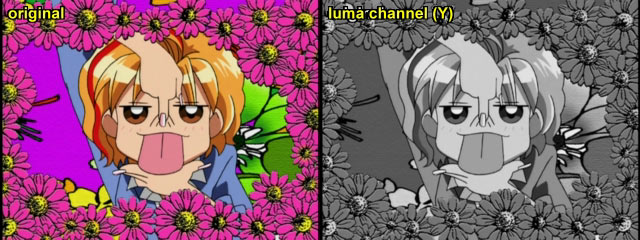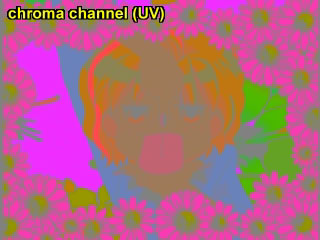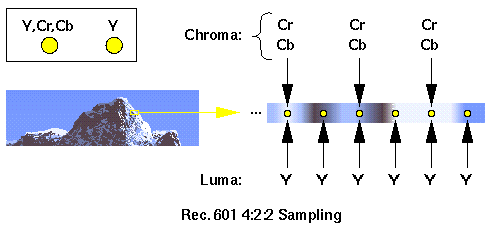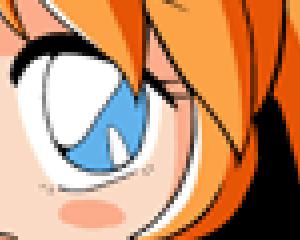Colorspace
"The real trick to optimizing color space conversions is of
course to not do them." --trbarry, April 2002
When storing video digitally there are two philosophies in
which you can store it: RGB and YUV. Each has a
variation or two that change how accurate they are, but that's it (i.e.
RGB16,RGB24,RGB32 and then YUV, YUY2, YV12, I420 etc).
RGB stores video rather intuitively. It stores a color
value for each of the 3 color levels, Red Green and Blue, on a per
pixel basis. The most common RGB on computers these days is RGB24 which
gives 8 bits to each color level (that's what gives us the 0-255 range
as 2 to the 8th power is 256), thus white is 255,255,255 and black is
0,0,0.
RGB uses the fact that three color components can be added
together to create any color. In contrast, YUV stores the
color the same way human brain
works.
Now comes an explaination: the primary thing that human brain
acknowledges is
brightness, aka "luma".
Luma can be relatively
easly calculated from RGB channels by averaging the color values and
giving more weight to some colors over others to find out the luma
value.
Scientists came up with weights that match human
perception where green has high contribution, red half of that, blue -
one
third of red. Why this is the case is simply a matter of the way the
brain works and this perceptive model is important in how YUV was
developed.
Luma is a simple positive value where zero means black and high values
mean white.
As for the color information, things are not so easy. They are called U
and V (or sometimes Cb and Cr respecitvely). They can have both
positive and
negative values which match the way color is processed in our brain.
Cr, when positive, means that the object is red.
Cr negative means that the object is green.
Our
brain understands
these two colors as opposites - If you think about it, no object can
ever be red-greenish.
Cb, when positive, indicates
blue object. Cb negative means yellow.
Again, they are the opposites for our brain and so we have the
reasoning behind YUV as a color methodology.
So, why is it useful to store pictures in YUV?
There are several reasons for storing in YUV
- a historical reason: when color TV was invented, it
needed to
be both backwards and forwards compatible with black-and-white TV. The
old B&W channel became luminance, while two color channels were
added on top of that. Old TVs simply ignore the two extra channels
while color TVs just understand that chroma is zero in B&W signal.
- you get channels that are regularly uncorrelated - if shadows
move, only one channel is affected. This helps video compression quite
a lot,
because the same information is not repeated for different channels.
- you get one channel that is much more
important, and two
channels that are less important (but necessary). You can do tricks
with this idea, as you will see.
So, when dealing with YUV you can imagine Y as being the black
and white image then U
and V as the "coloring" of the image. Here's a visual example:


You can see straight away that the color information is much less
detailed. This is true, but even if it wasn't the reality is that you
just can't notice detail as much in the chroma channel (remember
biology - rods and cones... you have more rods, you can't actually see
colour as clearly as you can see luma.)
Although you can have one Y, U and V sample per pixel like you
do with R,G and B, it is common for the chroma samples (the U and V) to
be sampled less often because the accuracy of the chroma is less
noticable. There are a many ways to do this but we are going
to demonstrate the two that you will deal with most - YUY2 and YV12.
YUY2 is a type of YUV that samples the luma once every
pixel
but only samples the chroma once every horizontal pair of pixels - the
point being that the human eye doesn't really notice that the chroma of
the two pixels is the same when the luma values are different. It's
just like the way you can be less accurate when coloring in a black and
white picutre than if you were making the picture from scratch with
only colored pencils.

So basically YUY2 stores color data at a lower accuracy than
RGB without us really noticing that much. Effectively what happens is
that the chroma information is half the regular vertical resolution.
Due to this nature of YUY2, when you convert between YUY2 and
RGB you either lose some data (as the chroma is averaged), or
assumptions have to be made and data must be guessed at or interpolated
(because the chroma is averaged already we can't find out what the real
value was before).
Even less chroma sampling: YV12
YV12 is much like YUY2 but takes this one step further. Where YUY2
samples chroma once in every 2 pixels in a row, YV12 samples chroma
once in
every 2x2 pixel block! You'd think that only having one chroma sample
in a 2x2 square would look terrible but the fact is that we don't
really
notice the difference all that much. Of course, because there are so
many less chroma samples (it's effectively half the resoltion than the
luma) there is less information to store which is
great for saving bits. All major distribution codecs use a 1 chroma for
4
pixels method - including MPEG2 on DVDs.
The top image is an original and below it is an image sampled
with YUV 4:2:0 (YV12) sampling , notice how the colors of the hairline
at the top left become puzzled because of the chroma averaging between
pixels.


The sharp among you may think "um ok but what if the image is
interlaced - you'd be sampling color from two different fields!" and
you'd be right... which is why YV12 interlaced footage has to be
sampled a field at a time instead of a frame at a time.
Colorspace Conversions
Converting back and forth between colorspaces is bad because
you can lose detail, as mentioned, and it also slows things down. So,
you want to avoid colorspace conversions as much as possible. But how?
Well, you need to know two things - the colorspace of your
footage and the colorspace used by your programs.
Footage Colorspaces:
DVDs - These use MPEG2 with 4:2:0 YUV (YV12) color.
There is one chroma sample for each square of 2x2 pixels (unlike the
YUY2 picture above which has one chroma for each group of 2x1 pixels).
DV - This uses 4:1:1 YUV which has the same number
of chroma samples as MPEG2 but in a different order.
Mjpeg - This can use all kinds of YUV sampling but
4:2:0 (YV12) is very common.
MPEG1, 2 and 4 (divx etc) all use YV12 color
(although they can technically support other YUV modes in theory, just
not in practice). There are MPEG2 profiles (such as the Studio Profile)
which can deal with 4:2:2 chorma but mostly you will see 4;2:0 chroma
being used.
HuffYUV - currently YUY2 and RGB storage is
possible. YV12 is developmental.
Programs:
Premiere, and almost all video editing programs, work
in RGB because it's easier to deal with mathematically. Premiere
demands that all incoming video should be in RGB32 - or 24-bit color
with 8-bit alpha channel, specifically, and will convert the YUV
footage you give it to that format for processing. Even Premiere Pro
which hailed itself as being able to support YUV formats can only
support 4:4:4 uncompressed YUV which is hardly any different from RGB.
The native DV support is useful but it still doesn't warrant all the
hype as very few of the plugins (including Adobe's own sample code)
actually use the YUV support at all.
AVISynth can work in either colorspace, but YUV is
preferred by many filters and most (if not all) AVISynth filters run in
YV12 colorspace these days - which is fine as it is the format used by
DVD and other distributable forms like mpeg1, mpeg4 and so on.
TMPGEnc's VFAPI plugins all operate in RGB colorspace
because all of its filtering and processing runs in RGB.
This is also true of FlaskMPEG (mostly)
VirtualDub (and variants) run in RGB mode when you
use Normal Recompress or Full Processing Mode (in the Video dropdown
menu). All of VirtualDub's internal functions and filters run in RGB
colorspace only. However, Fast Recompress doesn't decode the video to
RGB, and instead just shunts whatever your source is into the
compressor you've selected - thus if your source is a YUV type then it
shunts the video data as YUV into the video compressor.
This is, of course, important because you need to know what
conversion has to take place if you use source X in program Y or
compress a certain format X using program Y.
For example, using Fast Recompress in VirtualDub
(or any of its variants) is not only the fastest way to transcode video
but also the least costly in terms of colorspace conversions. The
drawback is you cannot you any of VirtualDub's filters in Fast
Recompress mode - VirtualDub never even touches the incoming video
stream.. which is why you should use AviSynth for any video processing
work.
By scripting all your filters in AVISynth you can avoid many
color
conversions. The optimal scenario involves only 2 colorspace
conversions: MPEG2 from DVD in YV12, processed with Avisynth in YV12
and then converted to RGB32 ready for
editing. RGB export form editing program using Huffyuv in RGB mode and
then converted to YV12
ready for the final video compressor. By doing this you not
only save time but also quality by avoiding colorspace conversions.
Many people once used YUY2 mode in HuffYUV all the time
thinking it was lossless - so they would import into Premiere, edit,
export to YUY2, import again, edit, export again and each time it went
into Premiere it was being converted into RGB and each time it was
compressed to HuffYUV it was being converted to YUY2. This has lead to
many faded-looking videos in the past.
Thankfully, with a little knowledge of these colorspaces, you
can avoid doing this or at least only do it when you really need to.
ErMaC, AbsoluteDestiny and
Syskin -
April 2004
|




